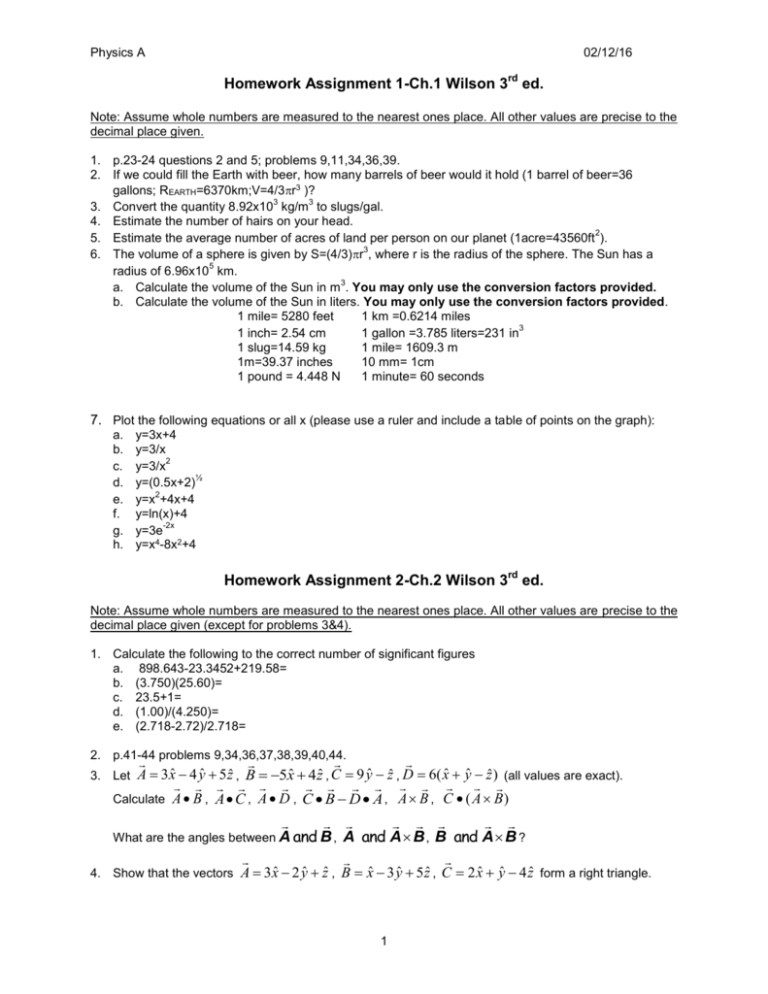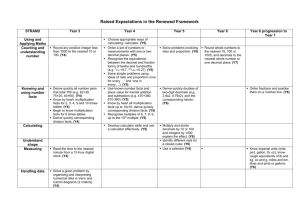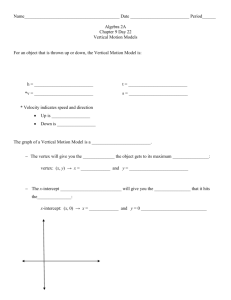Homework Assignment 2-Ch - Sierra College
advertisement

Physics A 02/12/16 Homework Assignment 1-Ch.1 Wilson 3rd ed. Note: Assume whole numbers are measured to the nearest ones place. All other values are precise to the decimal place given. 1. p.23-24 questions 2 and 5; problems 9,11,34,36,39. 2. If we could fill the Earth with beer, how many barrels of beer would it hold (1 barrel of beer=36 gallons; REARTH=6370km;V=4/3r3 )? 3 3 3. Convert the quantity 8.92x10 kg/m to slugs/gal. 4. Estimate the number of hairs on your head. 2 5. Estimate the average number of acres of land per person on our planet (1acre=43560ft ). 3 6. The volume of a sphere is given by S=(4/3)r , where r is the radius of the sphere. The Sun has a 5 radius of 6.96x10 km. 3 a. Calculate the volume of the Sun in m . You may only use the conversion factors provided. b. Calculate the volume of the Sun in liters. You may only use the conversion factors provided. 1 mile= 5280 feet 1 km =0.6214 miles 3 1 inch= 2.54 cm 1 gallon =3.785 liters=231 in 1 slug=14.59 kg 1 mile= 1609.3 m 1m=39.37 inches 10 mm= 1cm 1 pound = 4.448 N 1 minute= 60 seconds 7. Plot the following equations or all x (please use a ruler and include a table of points on the graph): a. b. c. d. e. f. g. h. y=3x+4 y=3/x 2 y=3/x ½ y=(0.5x+2) 2 y=x +4x+4 y=ln(x)+4 -2x y=3e 4 y=x -8x2+4 Homework Assignment 2-Ch.2 Wilson 3rd ed. Note: Assume whole numbers are measured to the nearest ones place. All other values are precise to the decimal place given (except for problems 3&4). 1. Calculate the following to the correct number of significant figures a. 898.643-23.3452+219.58= b. (3.750)(25.60)= c. 23.5+1= d. (1.00)/(4.250)= e. (2.718-2.72)/2.718= 2. p.41-44 problems 9,34,36,37,38,39,40,44. B 5xˆ 4zˆ , C 9 yˆ zˆ , D 6( xˆ yˆ zˆ ) (all values are exact). Calculate A B , A C , A D , C B D A , A B , C ( A B ) 3. Let A 3 xˆ 4 yˆ 5 zˆ , A and A B , B and A B ? 4. Show that the vectors A 3 xˆ 2 yˆ zˆ , B xˆ 3 yˆ 5 zˆ , C 2 xˆ yˆ 4 zˆ form a right triangle. What are the angles between A and B , 1 Physics A 02/12/16 Homework Assignment 3-Ch.3 WILSON 3rd ed. Note: Assume whole numbers are measured to the nearest ones place. All other values are precise to the decimal place given. 1. pp. 65-66 questions 5-8,14. 2. pp. 67-70 problems 4,6,7,9,17,18,24,26,30,35,36. Draw free body diagrams for all problems except 4&6. Homework Assignment 4-Ch.12.1,12.2,15.1 WILSON 3rd ed. Note: Assume whole numbers are measured to the nearest ones place. All other values are precise to the decimal place given. 1. 2. 3. 4. pp .252-253 questions 4, 12, and 20. pp. 252-253 problems 2,6,14. pp. 317-321 problems 7,10 Two spheres are cut from a uniform material. One has a radius of 5.00 cm. The mass of the other sphere is 16 times greater. Find its radius. Homework Assignment 5-Ch. 4 WILSON 3rd ed. 1. 2. 3. 4. 5. 6. pp. 82-85 questions 14,15,16, and 21. pp. 82-85 problems 8,14,18, 26,31,32,34,37,41(try using the quadratic formula). Plot graphs of position, velocity, and acceleration as functions of time for problem 18. Plot graphs of velocity and acceleration as functions of time for problem 31. Plot graphs of velocity and position as functions of time for problem 41. John is standing on the roof of a building 23.0 m above the ground. He throws a water balloon straight up with an initial velocity of 9.8 m/s. At the instant the water balloon is released, he also drops an open beer bottle falls off the roof. Ignore air resistance. a. When does the water balloon hit the ground? b. What is the time difference between when the beer bottle hits the ground and the water balloon hits the ground? c. What is the speed at which the water balloon hits the ground? d. When does the water balloon reach its maximum height? e. How high above the ground is the beer bottle when the water balloon is at its maximum height? Please use a ruler and include a table of points on your graph Homework Assignment 6-Ch. 5 WILSON 3rd ed. Note: Assume whole numbers are measured to the nearest ones place. All other values are precise to the decimal place given. 1. 2. 3. 4. pp. 98-100 questions 8,17. pp. 98-100 problems 13,15,16,17,23,24,27,31,32. Calculate the final velocity of the object in problem 15 when it hits the ground. Plot graphs of y vs. x (vertical distance traveled vs. horizontal distance traveled) for problems 17 and 24. Please use a ruler, graph paper, and include a table of points on your graph. 2 Physics A 02/12/16 Homework Assignment 7-Ch. 6 WILSON 3rd ed. Note: Assume whole numbers are measured to the nearest ones place. All other values are precise to the decimal place given. 1. pp. 116-119 questions 5,17,21. 2. pp. 116-119 problems 10,13,19,20,21,22,23,24,26,29,31,32. 3. You are sitting in the back of a produce truck that has stopped at a red light. You want to measure its acceleration when the light turns green. You could actually measure the acceleration of the truck by measuring the increase in weight of a mass with a spring scale. You decide to hang a large potato on a spring scale. It weighs 4.90N. The light turns green. The truck begins to accelerate. As the truck accelerates apparent weight of the large potato increases to 5.00N as it swings from the vertical. a. Draw a free-body diagram indicating all the forces acting on the potato. b. Sum the forces in the x-direction. c. Sum the forces in the y-direction. d. To what angle does the potato swing from the vertical? What is the acceleration of the truck? Homework Assignment 8-Ch. 7 WILSON 3rd ed. Note: Assume whole numbers are measured to the nearest ones place. All other values are precise to the decimal place given. 1. pp. 144-148 questions 4,12,21,24,25. 2. pp. 144-148 problems 11,17,19,20,25,27. Homework Assignment 9-Ch. 9 WILSON 3rd ed. Note: Assume whole numbers are measured to the nearest ones place. All other values are precise to the decimal place given. 1. pp. 189-193 question 7,10,18,19. 2. pp. 189-193 problems 1,8,10,12,25,30a. Homework Assignment 10-Ch. 8 WILSON 3rd ed. Note: Assume whole numbers are measured to the nearest ones place. All other values are precise to the decimal place given. 1. pp. 172-174 questions 1,7,18. 2. pp 172-174 problems 6,8,24,26,28,30,31,32,41. 3. Plot a graph of F vs. x from x=0 to x=15m for problem 6a. Then calculate the area under the curve. Compare to your answer to 6a. Repeat for problem 10. 4. If a force F 3 xˆ 4 yˆ 5zˆ produces a displacement s xˆ 2zˆ , what is the work done on the object? Is the object speeding up or slowing down? 5. Go back to problem 8 on page 172 and answer the following questions. a. How much work does the normal force do on the box? b. What is its change in potential energy? c. How much work is done by the force that is pushing the box up the hill, if the velocity of the box is constant over the 8.0m it travels? d. What is the magnitude of this force? e. Suppose that the box is moving up the hill at a constant velocity of 2.0 m/s. If the applied force you calculated in part d is doubled, calculate the speed of the box after it has traveled 5.0-m (with the newly applied force). Remember, work done by the ALL the forces acting on the box equals the change in kinetic energy. 6. pp. 192-193 problems 19, 24. 3 Physics A 02/12/16 7. A land vehicle with a rocket propulsion system has a mass equal to 29,500 kg. It is being used in an attempt to break the land speed record. It starts from rest and reaches a velocity of 317.5 m/s in 8.257 seconds using a thrust of 1.84x106 N. a. What is the average acceleration of the vehicle? Note: Don’t use F=ma here. b. How much net force produces this acceleration. c. What is the kinetic energy of the land vehicle after 8.257 seconds? d. What is the change in kinetic energy of the rocket from its initial velocity to its final velocity? e. What is the work done by the net force? f. Are the answers to e and f the same? Do you expect this? Explain. Please use a ruler and include a table of points on your graph. Homework Assignment 11-Ch. 10 WILSON 3rd ed. Note: Assume whole numbers are measured to the nearest ones place. All other values are precise to the decimal place given. 1. pp. 212-214 problems 5,6,11,17,20,21,24,25,30,31,34,35 (Answer this follow up question too: Do the mass and the radius of the object matter?), 39 (assume R>>r),44,46,47. Homework Assignment 12-Ch. 27&28 WILSON 3rd ed. Note: Assume whole numbers are measured to the nearest ones place. All other values are precise to the decimal place given. 1. p.569 question 2. 2. p. 570 problems 1,4. 3. pp. 593-597 problems 8,10,15,17,18,19,20,28,30,34.All problems from sections 28.3 and 28.4 require ray diagrams for full credit. Please use a ruler. 4







